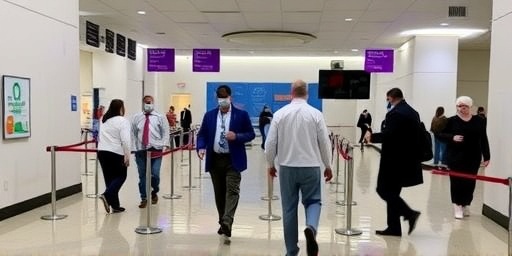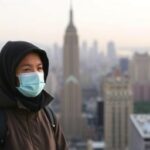Los Angeles County public health officials confirmed the season’s first Flu death on Wednesday, a stark reminder as influenza cases begin to climb across the region. The victim, a 78-year-old resident of the San Fernando Valley who was not vaccinated against the Flu, succumbed to complications from influenza A at a local hospital. This development has prompted an urgent call from county leaders for residents to prioritize vaccination before the winter peak hits.
- Victim’s Profile Highlights Vaccination Gaps in Elderly L.A. Residents
- Flu Cases Surge in Los Angeles Schools and Workplaces
- Health Department Launches Aggressive Vaccination Drive Across L.A.
- Vulnerable Groups Face Heightened Risks as Flu Peaks Approach
- Winter Outlook: What L.A. Residents Must Do to Avert Flu Crisis
With Flu activity already showing signs of escalation—hospitalizations up 25% in the past week compared to last season—experts warn that Los Angeles could face a more severe outbreak if vaccination rates don’t improve. “This tragic loss underscores the preventable nature of many flu-related illnesses,” said Dr. Barbara Ferrer, Director of the Los Angeles County Department of Public Health, in a press briefing. “We have ample vaccine supply, and getting vaccinated now is the single most effective way to protect yourself and your community.”
Victim’s Profile Highlights Vaccination Gaps in Elderly L.A. Residents
The deceased individual, whose identity has not been publicly released pending family notification, was reportedly in good health prior to contracting the flu but had underlying conditions including diabetes and heart disease—factors that public health experts identify as high-risk for severe outcomes. According to preliminary investigations, the patient sought medical attention after experiencing fever, cough, and shortness of breath for several days before rapid deterioration.
This case aligns with national trends where unvaccinated seniors over 65 account for a disproportionate share of flu fatalities. In Los Angeles County alone, last season saw 142 flu-related deaths, with 70% occurring among those who skipped the annual shot. Current vaccination rates hover at just 45% for adults over 65, well below the 70% target set by federal health guidelines.
“It’s heartbreaking but not unexpected,” noted Dr. Rachel Villanueva, an infectious disease specialist at Cedars-Sinai Medical Center. “Flu viruses mutate yearly, and this season’s strains are particularly aggressive. Vaccination reduces hospitalization risk by up to 50% and death by 40-60%, per CDC data.” She emphasized that even those previously vaccinated should get the updated 2024-2025 formula, which targets dominant H1N1 and H3N2 strains circulating in Los Angeles.
- Key Risk Factors: Age 65+, chronic illnesses, unvaccinated status.
- County Flu Deaths Last Season: 142 total, per L.A. Department of Public Health.
- Current Hospitalizations: 1,200 flu-positive patients countywide, a 25% week-over-week increase.
Flu Cases Surge in Los Angeles Schools and Workplaces
As the first flu death grabs headlines, surveillance data reveals a broader uptick in influenza across Los Angeles. Wastewater testing from major treatment plants shows viral loads 30% higher than the same period last year, while emergency room visits for flu-like symptoms have jumped 40% since mid-November.
Schools in districts like Los Angeles Unified School District (LAUSD) report absenteeism rates climbing to 12%, with clusters in elementary schools where child vaccination rates lag at 55%. Workplaces aren’t spared either; major employers like the Port of Los Angeles have noted increased sick days, prompting on-site vaccination clinics.
The California Department of Public Health corroborates these trends, reporting over 5,000 lab-confirmed flu cases statewide in the past month, with Southern California bearing the brunt. “We’re seeing widespread activity earlier than usual,” stated state epidemiologist Dr. Tomás Aragón. “Public health measures like masking in crowded spaces and hand hygiene remain crucial alongside vaccination.”
Historical context adds gravity: The 2017-2018 season, one of California’s worst, claimed over 700 lives, including 200 in L.A. County. This year’s early death signals potential parallels if trends continue unchecked.
Health Department Launches Aggressive Vaccination Drive Across L.A.
In response to the fatality, the L.A. County Department of Public Health rolled out an expanded vaccination initiative, dubbed “Flu Free LA,” targeting high-need areas like South L.A., East L.A., and the Antelope Valley. Free shots are now available at 200+ sites, including pharmacies, mobile clinics, and community centers, with walk-ins encouraged.
Funding from a $10 million state allocation supports Spanish- and Korean-language outreach, addressing barriers like misinformation and access. “We’ve vaccinated over 2.5 million residents so far this season, but we need to hit 4 million to bend the curve,” Dr. Ferrer urged. Partnerships with Kaiser Permanente and CVS Health ensure high-dose vaccines for seniors, proven 24% more effective in that group.
Effectiveness data bolsters the push: The 2024 vaccine matches circulating strains at 70-80%, per preliminary CDC estimates. Real-world studies from Australia’s recent flu season—similar to the U.S. Northern Hemisphere—showed 51% reduction in GP visits among the vaccinated.
- Mobile Clinics: Deployed to underserved neighborhoods starting this weekend.
- Pharmacy Incentives: $25 gift cards for vaccinated adults 18+.
- School Mandates: Encouraged flu shots for students and staff by December 15.
- Employer Programs: Tax credits for companies providing on-site vaccination.
Public response has been mixed; social media buzz around the death has spiked searches for “flu vaccine near me” by 300%, according to Google Trends data for Los Angeles.
Vulnerable Groups Face Heightened Risks as Flu Peaks Approach
Public health leaders are zeroing in on at-risk populations: children under 5, pregnant women, and immunocompromised individuals. In L.A., where 25% of residents are foreign-born, cultural hesitancy contributes to lower uptake—only 38% of pregnant women vaccinated versus a 50% national goal.
Hospitals like USC Keck Medical Center report pediatric ICUs at 85% capacity with flu and RSV cases overlapping. “Dual infections are deadly,” warned pediatrician Dr. Maria Gonzalez. “Vaccination is our frontline defense.”
National CDC figures paint a dire picture: Flu causes 12,000-52,000 U.S. deaths annually, with 140-710 pediatric fatalities. In Los Angeles, homeless populations—over 75,000 countywide—face outsized threats, prompting pop-up clinics at Skid Row.
Climate factors exacerbate spread: Unusually warm December weather has kept people indoors, boosting transmission in homes and transit hubs like LAX, where international arrivals seed new variants.
Winter Outlook: What L.A. Residents Must Do to Avert Flu Crisis
Forecasts from the CDC’s FluView predict moderate-to-high activity through March, with Los Angeles potentially mirroring Midwest surges. Modeling suggests 10,000+ local hospitalizations if vaccination stalls.
Officials outline proactive steps: Get vaccinated (protection kicks in within 2 weeks), stay home when sick, cover coughs, and avoid close contact with vulnerable loved ones. Antivirals like Tamiflu remain effective if started early.
“This first death is a wake-up call,” Dr. Ferrer concluded. “By vaccinating now, we can save lives and ease the burden on our healthcare system.” Clinics operate daily; appointments via 211 or lacounty.gov/flu. Community leaders, from Hollywood influencers to Latino chamber groups, are amplifying the message via PSAs and events.
As cases rise, monitoring by the county’s Flu Sentinel Network—tracking 50+ sites—will guide responses. Residents are encouraged to report symptoms via FluNearYou.org for real-time mapping. With concerted action, L.A. can mitigate what threatens to be a punishing flu season.









